Understanding Brain Lateralisation: Insights from Split Brain Research
VerifiedAdded on 2022/12/14
|6
|1395
|206
Report
AI Summary
This report delves into the realm of split brain studies, exploring their profound impact on our comprehension of brain lateralisation. It begins with an introduction to split brain research, highlighting the groundbreaking work of Roger Sperry and its significance in understanding cerebral symmet...
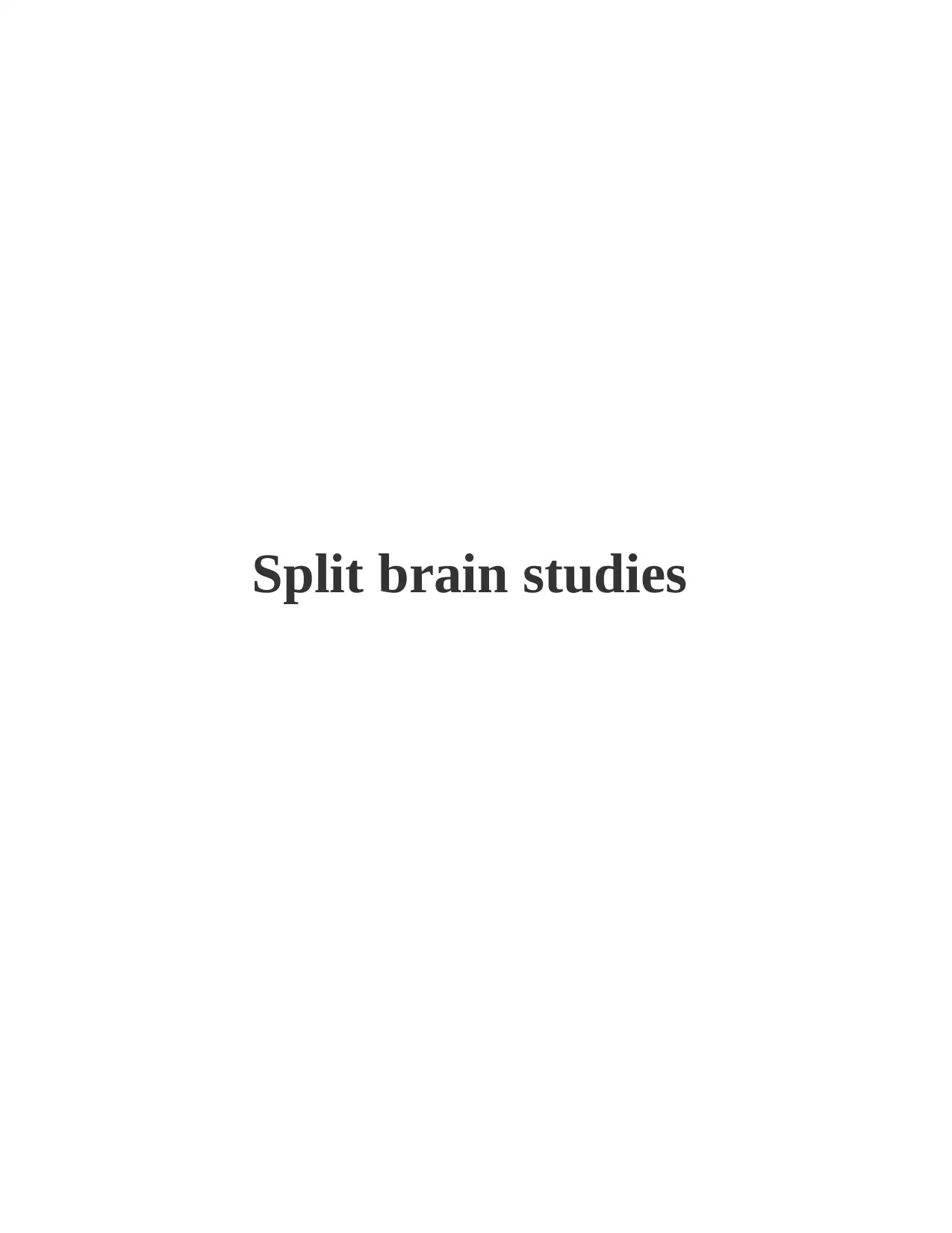
Split brain studies
Paraphrase This Document
Need a fresh take? Get an instant paraphrase of this document with our AI Paraphraser
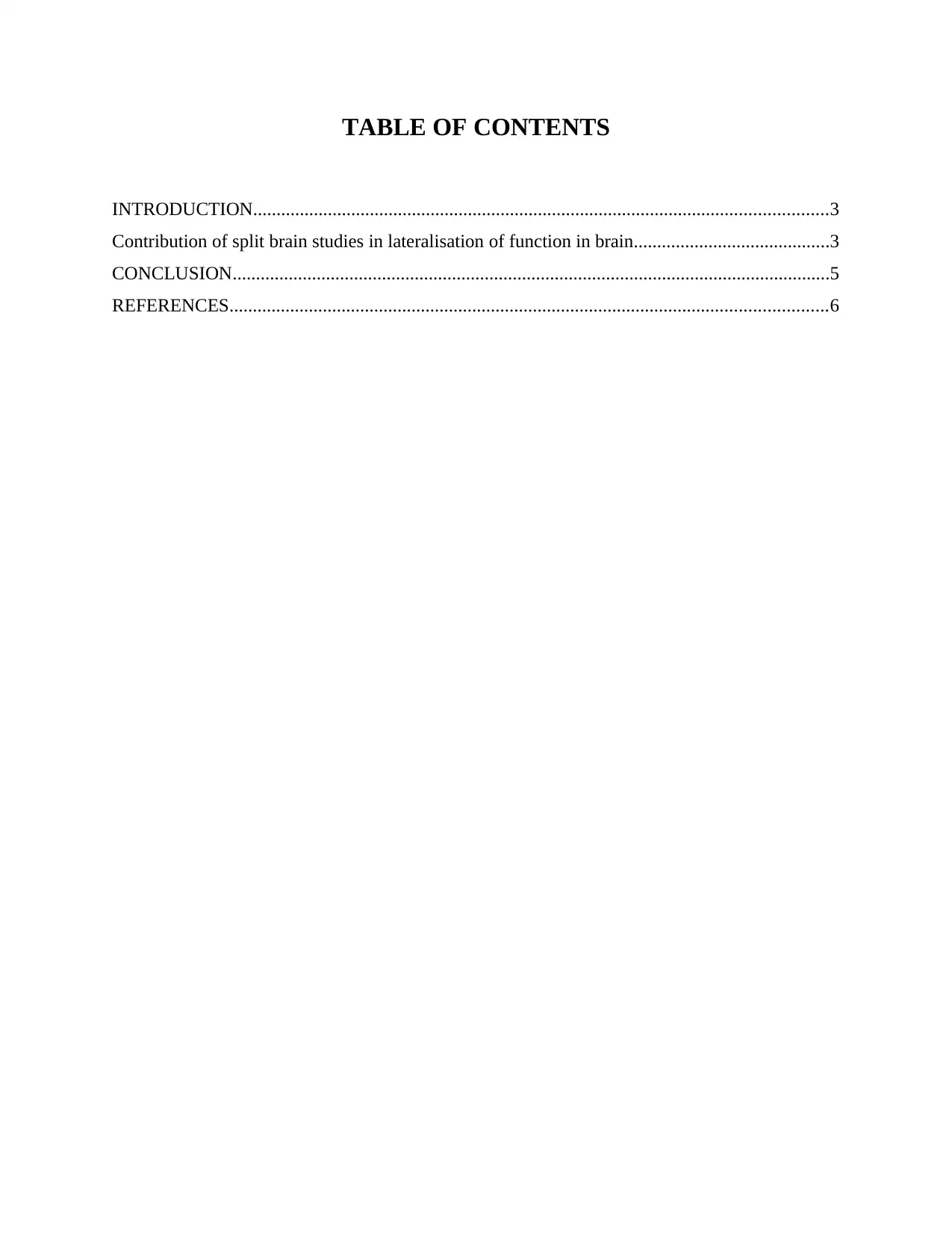
TABLE OF CONTENTS
INTRODUCTION...........................................................................................................................3
Contribution of split brain studies in lateralisation of function in brain..........................................3
CONCLUSION................................................................................................................................5
REFERENCES................................................................................................................................6
INTRODUCTION...........................................................................................................................3
Contribution of split brain studies in lateralisation of function in brain..........................................3
CONCLUSION................................................................................................................................5
REFERENCES................................................................................................................................6

INTRODUCTION
Split brain studies is also considered as the tale of two halves in which the hemispheres of
the brain of the people is separated for treating the epilepsy. The research of the split brain is
initiated by Roger Sperry for which he got the Nobel Prize in 1982 (Frasnelli and Vallortigara,
2018). These studies helps in clarifying the consciousness of the brain and the cerebral symmetry
of the cognitive strategies and the human motives which helps in guiding distinct purposes which
are in action. The report will shed light on the ways in which the split brain studies provides
information about the lateralisation function in the brain.
Contribution of split brain studies in lateralisation of function in brain
The study of split brain basically refers to studying and gaining deep insights about the
patients who are suffering from split brain. This is the problem when the corpus callosum which
is basically bundled of fibres which connects brain’s two hemispheres are destroyed for treating
the severe epilepsy (Volz and Gazzaniga, 2017). Split brain is considered as the brain of mamma
in which the direct ‘one-neuron’ connections which is present between the two forebrain cerebral
cortices is destroyed or cut completely. Among all these connections, the largest bridge which is
interhemispheric is referred as corpus callosum. After doing the studies of the split brain, one can
easily come to know about the lateralization of function in brain which is considered as the
functional dominance of a hemisphere over another in which only one hemisphere is responsible
for performing the functions in the brain as compared to the functions performed by others
(Stanković, 2020). This is well known that right and left sides of the brain are known for
performing certain specialized skills but being two different hemispheres they are connected to
each other and communicate with each other regularly.
The studies of split brain helps in knowing that the cerebral hemispheres are separated by the
corpus collosum being severe. In this case the patients sometimes behave as they have one brain
and sometimes they behave in such a way that they have two brains. This can also be observed
from the studies that people who have loss of contact among their both the bilateral hemispheres
can lead to pseudobulbar palsy, mental disorders, movement and speech ataxia (de Haan and
et.al., 2020). The best example for the lateralization function in brain is the Wernicke’s and
Broca’s areas where both are located on the left hemisphere instead of being both on both the left
3
Split brain studies is also considered as the tale of two halves in which the hemispheres of
the brain of the people is separated for treating the epilepsy. The research of the split brain is
initiated by Roger Sperry for which he got the Nobel Prize in 1982 (Frasnelli and Vallortigara,
2018). These studies helps in clarifying the consciousness of the brain and the cerebral symmetry
of the cognitive strategies and the human motives which helps in guiding distinct purposes which
are in action. The report will shed light on the ways in which the split brain studies provides
information about the lateralisation function in the brain.
Contribution of split brain studies in lateralisation of function in brain
The study of split brain basically refers to studying and gaining deep insights about the
patients who are suffering from split brain. This is the problem when the corpus callosum which
is basically bundled of fibres which connects brain’s two hemispheres are destroyed for treating
the severe epilepsy (Volz and Gazzaniga, 2017). Split brain is considered as the brain of mamma
in which the direct ‘one-neuron’ connections which is present between the two forebrain cerebral
cortices is destroyed or cut completely. Among all these connections, the largest bridge which is
interhemispheric is referred as corpus callosum. After doing the studies of the split brain, one can
easily come to know about the lateralization of function in brain which is considered as the
functional dominance of a hemisphere over another in which only one hemisphere is responsible
for performing the functions in the brain as compared to the functions performed by others
(Stanković, 2020). This is well known that right and left sides of the brain are known for
performing certain specialized skills but being two different hemispheres they are connected to
each other and communicate with each other regularly.
The studies of split brain helps in knowing that the cerebral hemispheres are separated by the
corpus collosum being severe. In this case the patients sometimes behave as they have one brain
and sometimes they behave in such a way that they have two brains. This can also be observed
from the studies that people who have loss of contact among their both the bilateral hemispheres
can lead to pseudobulbar palsy, mental disorders, movement and speech ataxia (de Haan and
et.al., 2020). The best example for the lateralization function in brain is the Wernicke’s and
Broca’s areas where both are located on the left hemisphere instead of being both on both the left
3
⊘ This is a preview!⊘
Do you want full access?
Subscribe today to unlock all pages.

Trusted by 1+ million students worldwide
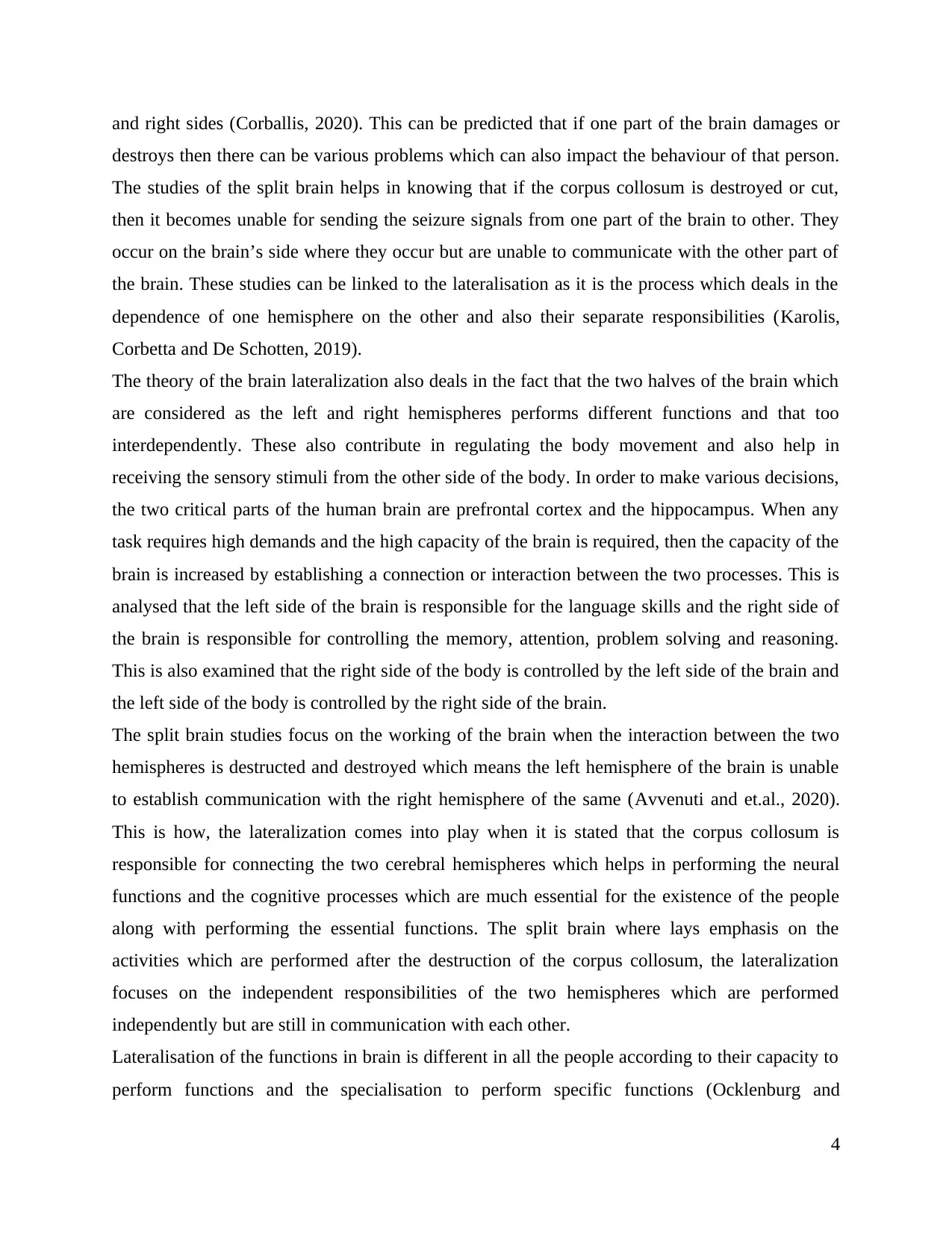
and right sides (Corballis, 2020). This can be predicted that if one part of the brain damages or
destroys then there can be various problems which can also impact the behaviour of that person.
The studies of the split brain helps in knowing that if the corpus collosum is destroyed or cut,
then it becomes unable for sending the seizure signals from one part of the brain to other. They
occur on the brain’s side where they occur but are unable to communicate with the other part of
the brain. These studies can be linked to the lateralisation as it is the process which deals in the
dependence of one hemisphere on the other and also their separate responsibilities (Karolis,
Corbetta and De Schotten, 2019).
The theory of the brain lateralization also deals in the fact that the two halves of the brain which
are considered as the left and right hemispheres performs different functions and that too
interdependently. These also contribute in regulating the body movement and also help in
receiving the sensory stimuli from the other side of the body. In order to make various decisions,
the two critical parts of the human brain are prefrontal cortex and the hippocampus. When any
task requires high demands and the high capacity of the brain is required, then the capacity of the
brain is increased by establishing a connection or interaction between the two processes. This is
analysed that the left side of the brain is responsible for the language skills and the right side of
the brain is responsible for controlling the memory, attention, problem solving and reasoning.
This is also examined that the right side of the body is controlled by the left side of the brain and
the left side of the body is controlled by the right side of the brain.
The split brain studies focus on the working of the brain when the interaction between the two
hemispheres is destructed and destroyed which means the left hemisphere of the brain is unable
to establish communication with the right hemisphere of the same (Avvenuti and et.al., 2020).
This is how, the lateralization comes into play when it is stated that the corpus collosum is
responsible for connecting the two cerebral hemispheres which helps in performing the neural
functions and the cognitive processes which are much essential for the existence of the people
along with performing the essential functions. The split brain where lays emphasis on the
activities which are performed after the destruction of the corpus collosum, the lateralization
focuses on the independent responsibilities of the two hemispheres which are performed
independently but are still in communication with each other.
Lateralisation of the functions in brain is different in all the people according to their capacity to
perform functions and the specialisation to perform specific functions (Ocklenburg and
4
destroys then there can be various problems which can also impact the behaviour of that person.
The studies of the split brain helps in knowing that if the corpus collosum is destroyed or cut,
then it becomes unable for sending the seizure signals from one part of the brain to other. They
occur on the brain’s side where they occur but are unable to communicate with the other part of
the brain. These studies can be linked to the lateralisation as it is the process which deals in the
dependence of one hemisphere on the other and also their separate responsibilities (Karolis,
Corbetta and De Schotten, 2019).
The theory of the brain lateralization also deals in the fact that the two halves of the brain which
are considered as the left and right hemispheres performs different functions and that too
interdependently. These also contribute in regulating the body movement and also help in
receiving the sensory stimuli from the other side of the body. In order to make various decisions,
the two critical parts of the human brain are prefrontal cortex and the hippocampus. When any
task requires high demands and the high capacity of the brain is required, then the capacity of the
brain is increased by establishing a connection or interaction between the two processes. This is
analysed that the left side of the brain is responsible for the language skills and the right side of
the brain is responsible for controlling the memory, attention, problem solving and reasoning.
This is also examined that the right side of the body is controlled by the left side of the brain and
the left side of the body is controlled by the right side of the brain.
The split brain studies focus on the working of the brain when the interaction between the two
hemispheres is destructed and destroyed which means the left hemisphere of the brain is unable
to establish communication with the right hemisphere of the same (Avvenuti and et.al., 2020).
This is how, the lateralization comes into play when it is stated that the corpus collosum is
responsible for connecting the two cerebral hemispheres which helps in performing the neural
functions and the cognitive processes which are much essential for the existence of the people
along with performing the essential functions. The split brain where lays emphasis on the
activities which are performed after the destruction of the corpus collosum, the lateralization
focuses on the independent responsibilities of the two hemispheres which are performed
independently but are still in communication with each other.
Lateralisation of the functions in brain is different in all the people according to their capacity to
perform functions and the specialisation to perform specific functions (Ocklenburg and
4
Paraphrase This Document
Need a fresh take? Get an instant paraphrase of this document with our AI Paraphraser
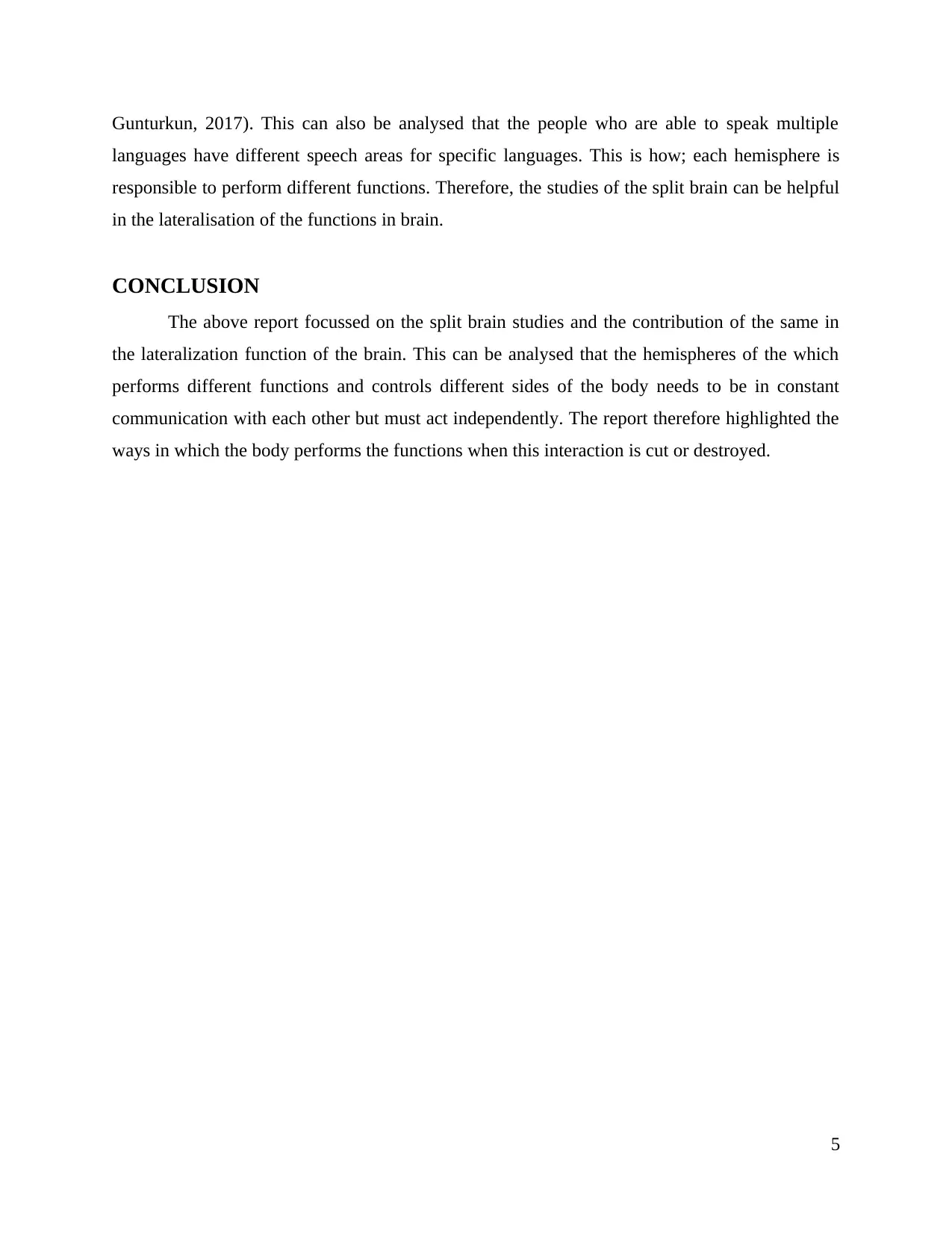
Gunturkun, 2017). This can also be analysed that the people who are able to speak multiple
languages have different speech areas for specific languages. This is how; each hemisphere is
responsible to perform different functions. Therefore, the studies of the split brain can be helpful
in the lateralisation of the functions in brain.
CONCLUSION
The above report focussed on the split brain studies and the contribution of the same in
the lateralization function of the brain. This can be analysed that the hemispheres of the which
performs different functions and controls different sides of the body needs to be in constant
communication with each other but must act independently. The report therefore highlighted the
ways in which the body performs the functions when this interaction is cut or destroyed.
5
languages have different speech areas for specific languages. This is how; each hemisphere is
responsible to perform different functions. Therefore, the studies of the split brain can be helpful
in the lateralisation of the functions in brain.
CONCLUSION
The above report focussed on the split brain studies and the contribution of the same in
the lateralization function of the brain. This can be analysed that the hemispheres of the which
performs different functions and controls different sides of the body needs to be in constant
communication with each other but must act independently. The report therefore highlighted the
ways in which the body performs the functions when this interaction is cut or destroyed.
5
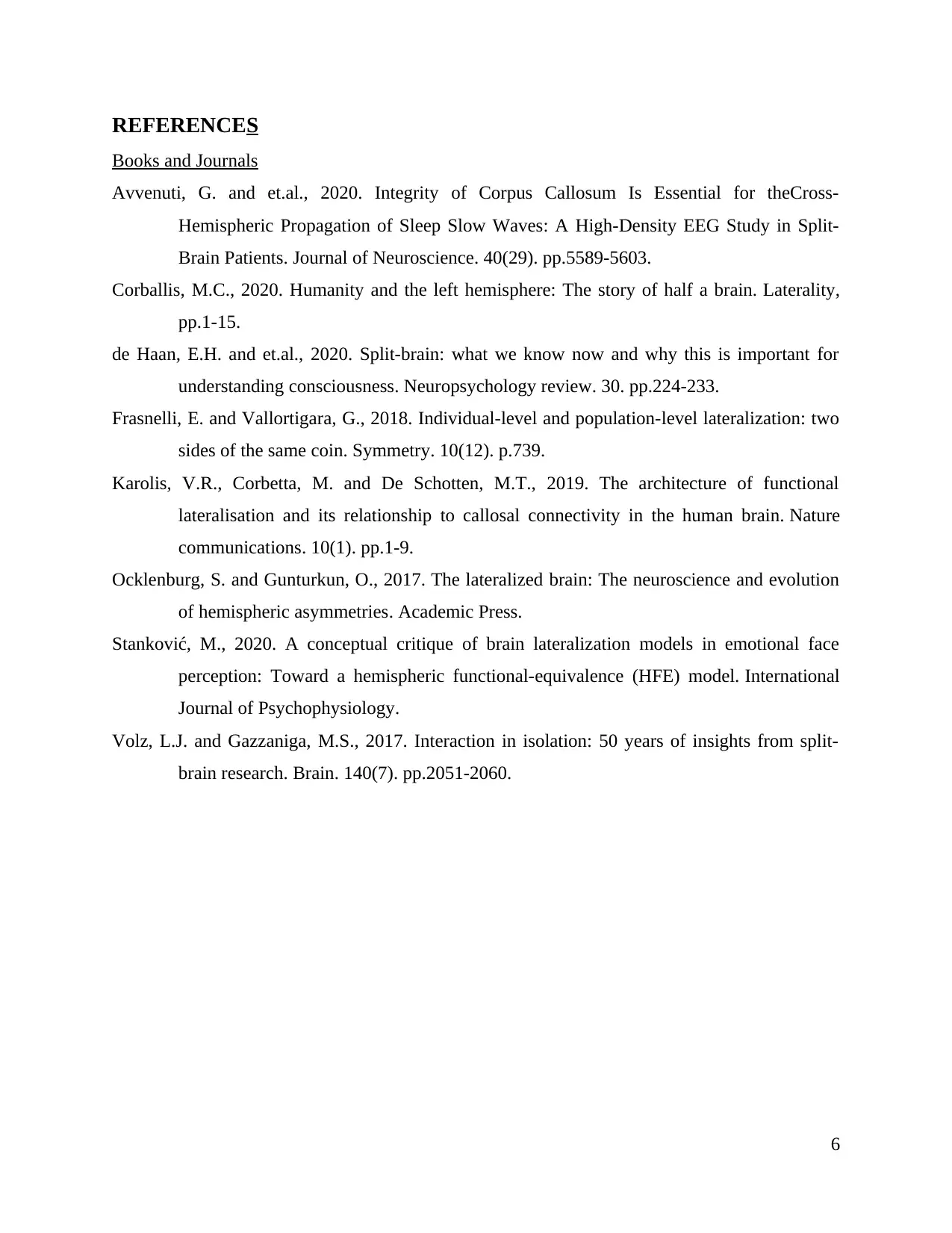
REFERENCES
Books and Journals
Avvenuti, G. and et.al., 2020. Integrity of Corpus Callosum Is Essential for theCross-
Hemispheric Propagation of Sleep Slow Waves: A High-Density EEG Study in Split-
Brain Patients. Journal of Neuroscience. 40(29). pp.5589-5603.
Corballis, M.C., 2020. Humanity and the left hemisphere: The story of half a brain. Laterality,
pp.1-15.
de Haan, E.H. and et.al., 2020. Split-brain: what we know now and why this is important for
understanding consciousness. Neuropsychology review. 30. pp.224-233.
Frasnelli, E. and Vallortigara, G., 2018. Individual-level and population-level lateralization: two
sides of the same coin. Symmetry. 10(12). p.739.
Karolis, V.R., Corbetta, M. and De Schotten, M.T., 2019. The architecture of functional
lateralisation and its relationship to callosal connectivity in the human brain. Nature
communications. 10(1). pp.1-9.
Ocklenburg, S. and Gunturkun, O., 2017. The lateralized brain: The neuroscience and evolution
of hemispheric asymmetries. Academic Press.
Stanković, M., 2020. A conceptual critique of brain lateralization models in emotional face
perception: Toward a hemispheric functional-equivalence (HFE) model. International
Journal of Psychophysiology.
Volz, L.J. and Gazzaniga, M.S., 2017. Interaction in isolation: 50 years of insights from split-
brain research. Brain. 140(7). pp.2051-2060.
6
Books and Journals
Avvenuti, G. and et.al., 2020. Integrity of Corpus Callosum Is Essential for theCross-
Hemispheric Propagation of Sleep Slow Waves: A High-Density EEG Study in Split-
Brain Patients. Journal of Neuroscience. 40(29). pp.5589-5603.
Corballis, M.C., 2020. Humanity and the left hemisphere: The story of half a brain. Laterality,
pp.1-15.
de Haan, E.H. and et.al., 2020. Split-brain: what we know now and why this is important for
understanding consciousness. Neuropsychology review. 30. pp.224-233.
Frasnelli, E. and Vallortigara, G., 2018. Individual-level and population-level lateralization: two
sides of the same coin. Symmetry. 10(12). p.739.
Karolis, V.R., Corbetta, M. and De Schotten, M.T., 2019. The architecture of functional
lateralisation and its relationship to callosal connectivity in the human brain. Nature
communications. 10(1). pp.1-9.
Ocklenburg, S. and Gunturkun, O., 2017. The lateralized brain: The neuroscience and evolution
of hemispheric asymmetries. Academic Press.
Stanković, M., 2020. A conceptual critique of brain lateralization models in emotional face
perception: Toward a hemispheric functional-equivalence (HFE) model. International
Journal of Psychophysiology.
Volz, L.J. and Gazzaniga, M.S., 2017. Interaction in isolation: 50 years of insights from split-
brain research. Brain. 140(7). pp.2051-2060.
6
⊘ This is a preview!⊘
Do you want full access?
Subscribe today to unlock all pages.

Trusted by 1+ million students worldwide
1 out of 6
Related Documents
Your All-in-One AI-Powered Toolkit for Academic Success.
+13062052269
info@desklib.com
Available 24*7 on WhatsApp / Email
![[object Object]](/_next/static/media/star-bottom.7253800d.svg)
Unlock your academic potential
© 2024 | Zucol Services PVT LTD | All rights reserved.




